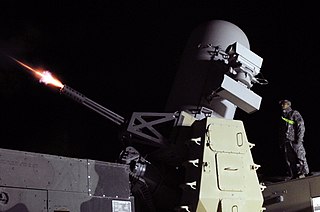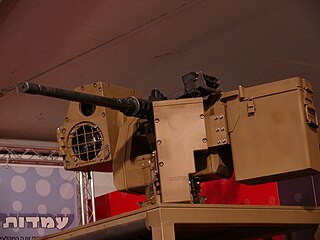Rafael Advanced Defense Systems Ltd., is an Israeli defense technology company. It was founded as Israel's National R&D Defense Laboratory for the development of weapons and military technology within the Israeli Ministry of Defense; in 2002 it was incorporated as a limited company.

The Republic of Singapore Navy (RSN) is the naval service branch of the Singapore Armed Forces (SAF) responsible for defending the country against any sea-borne threats, and the protection of its sea lines of communications, that would compromise Singapore as a global trading hub. The RSN traces its origins to the Royal Navy when Singapore was still a Crown colony of the British Empire. After Singapore's independence from Malaysia in 1965, the service was formally established in 1967, and had undergone a substantial modernisation ever since—which led them into becoming the most powerful navy in Southeast Asia.

The M242 Bushmaster chain gun is a 25 mm (25×137mm) single-barrel chain-driven autocannon. It is used extensively by the U.S. military, such as in the Bradley fighting vehicle, as well as by other NATO members and some other nations in ground combat vehicles and various watercraft. Hughes Helicopters in Culver City, California, was the original designer and manufacturer. McDonnell Douglas Helicopters acquired Hughes Helicopters in 1985, and merged into Boeing Corporation in 1997. In 2002, it was sold again to Alliant Techsystems, which merged with Orbital Sciences Corporation in 2015 to form Orbital Science ATK and was, in turn, bought out by Northrop Grumman in 2018. As of 2019, Northrop Grumman Innovation Systems produces the gun.
Spartan Scout, an Advanced Concept Technology Demonstration, is a crewless surface watercraft, also known as an unmanned surface vehicle (USV) developed by the United States in 2001, and first demonstrated in late 2003. The craft, a rigid hull inflatable boat, weighs 2 tons, and is 7 metres (23 ft) in length. It has a .50 caliber machine gun, as well as various sensors such as electro-optical and infrared surveillance and surface search radar. The Spartan is capable of carrying a 3,000-pound (1,400 kg) payload. According to a press release from the United States Navy, the Spartan Scout will also come in a 11-metre (36 ft) version, capable of carrying a 5,000-pound (2,300 kg) payload.

The M80 Stiletto is an American prototype naval ship using advanced stealth technologies. The M80 was designed by the M Ship Company then built by Knight and Carver, as an experimental testbed ship for The Pentagon’s Office of Force Transformation. It is notable for its innovative pentamaran hull design and advanced carbon fiber composite construction.

An unmanned surface vehicle (USV), also known as unmanned surface vessel, autonomous surface vehicle (ASV) in some cases, uncrewed surface vessel (USV), or, colloquially, a drone ship, or robot boat, is a boat or ship that operates on the surface of the water without a crew. USVs operate with various levels of autonomy, from remote control to fully autonomous.

Counter rocket, artillery, and mortar, abbreviated C-RAM or counter-RAM, is a set of systems used to detect and/or destroy incoming rockets, artillery, and mortar rounds in the air before they hit their ground targets, or simply provide early warning.

The Typhoon is a type of remote weapon station manufactured by Rafael Advanced Defense Systems of Israel, and it shares similar design principles and common technologies with Samson Remote Controlled Weapon Station, a land-based system manufactured by the same developer. Like Samson RCWS, Typhoon is also multi-configurable.

The Samson Remote Controlled Weapon Station (RCWS), also known as Katlanit is a Remote Weapon System that enables a variety of devices to be operated automatically or by remote control, including 5.56 mm, 7.62 mm, and 12.7 mm .50 BMG machine guns, 40 mm automatic grenade launchers, anti-tank missiles and observation pods. There are a total of three variants of the Samson family:

UAPS20 is an autopilot system that can be installed on an RHIB boat to obtain a low-cost unmanned surface vehicle.

The ASW Continuous Trail Unmanned Vessel (ACTUV) is a DARPA funded project launched in early 2010 to develop an anti-submarine drone. ASW is an acronym for Anti-Submarine Warfare. In January 2018 after successful sea trials it was announced that the "Sea Hunter" prototype has transitioned from DARPA to the Office of Naval Research for further development.

The Maritime Security Command is one of five operational commands of the Republic of Singapore Navy (RSN), responsible for building up, training and maintaining the capabilities of RSN platforms that are deployed primarily for maritime security operations. It was first established as the Coastal Command (COSCOM) in January 1988, before its restructuring in January 2009.

The Fleet-class unmanned surface vessel, also called the Common Unmanned Surface Vessel (CUSV) and later the Mine Countermeasures Unmanned Surface Vehicle, is an unmanned surface vessel designed for the United States Navy to be deployed from Freedom and Independence-class littoral combat ships and intended to conduct mine and anti-submarine warfare missions. As of 2012 four units of the class have been built; the first was delivered to the U.S. Navy in 2008.
Seaborne targets are vessels or floating structures that are shot at for practice by naval or air forces. They may be remotely controlled and mobile, or towed behind other craft, or just set adrift in the sea.

Sea Hunter is an autonomous unmanned surface vehicle (USV) launched in 2016 as part of the DARPA Anti-Submarine Warfare Continuous Trail Unmanned Vessel (ACTUV) program. The ship was christened 7 April 2016 in Portland, Oregon. It was built by Vigor Industrial. The vessel continues the line of experimental "Sea" ships, including Sea Shadow, Sea Fighter, Sea Jet, and Sea Slice. Sea Hunter is classified as a Class III USV and designated the Medium Displacement Unmanned Surface Vehicle (MDUSV).
ULAQ is the prototype of the first Turkish armed unmanned surface vessel (AUSV).
The JARI USV is an unmanned surface vehicle developed by the China Shipbuilding Industry Corporation (CSIC), specifically between its No. 716 Research Institute, the Jiangsu Automation Research Institute (JARI), and No. 702 Research Institute, China Ship Scientific Research Centre (CSRRC). The unmanned warship is designed for potential use for the People's Liberation Army Navy and export customers.
HUST USVs are unmanned surface vehicles developed by Huazhong University of Science and Technology (HUST), and by end of 2021, two USVs have been revealed to be in service:

The Mark 38 25 mm machine gun system (MGS) is a shipboard weapon system designed to protect warships primarily from a variety of surface threats, especially small, fast surface craft. It consists of an M242 Bushmaster chain gun mounted on a turret that can be either manually or remote controlled, depending on variant. Originally designed by the United States in the 1980s for use on their warships, the Mark 38 is today in service on warships of various NATO countries.

The Acero class is a ship class of nine patrol gunboats currently or incoming service with the Philippine Navy.
















